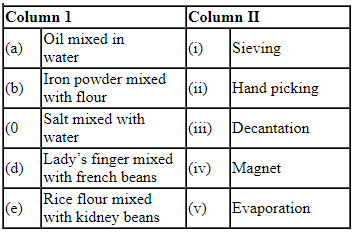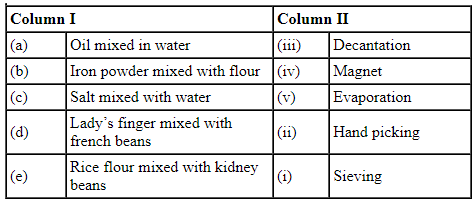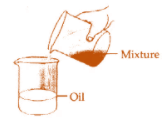NCERT Exemplar Solutions: Separation of Substances | Science for Class 6 PDF Download
Multiple Choice Questions
Q1: Paheli bought some vegetables such as French beans, lady’s finger, green chillies, brinjals and potatoes all mixed in a bag. Which of the following methods of separation would be most appropriate for her to separate them?
(a) Winnowing
(b) Sieving
(c) Threshing
(d) Hand-picking
 View Answer
View Answer 
Ans: (d)
Since the vegetables are big in size handpicking is the best method for separating the vegetables.
Q2: Boojho’s grandmother is suffering from diabetes. Her doctor advised her to take ‘Lassi’ with less fat content. Which of the following methods would be most appropriate for Boojho to prepare it?
(a) Filtration
(b) Decantation
(c) Churning
(d) Winnowing
 View Answer
View Answer 
Ans: (c)
Butter (fat) is separated by churning the curd and the remaining lassi contains less fat content.
Q3: Which of the following mixtures would you be able to separate using the method of filtration?
(a) Oil in water
(b) Cornflakes in milk
(c) Salt in water
(d) Sugar in milk
 View Answer
View Answer 
Ans: (b)
Since cornflakes are insoluble in milk it can be separated by the method of filtration.
Q4: Which amongst the following methods would be most appropriate to separate grains from bundles of stalks?
(a) Hand-picking
(b) Winnowing
(c) Sieving
(d) Threshing
 View Answer
View Answer 
Ans: (d)
To separate grains from bundles of stalks threshing is the best method.
Q5: Four mixtures are given below.
(i) Kidney beans and chickpeas
(ii) Pulses and rice
(iii) Rice flakes and corn
(iv) Potato wafers and biscuits
Which of these can be separated by the method of winnowing?
(a) (i) and (ii)
(b) (ii) and (iii)
(c) (i) and (iii)
(d) (iii) and (iv)
 View Answer
View Answer 
Ans: (d)
By using the method of winnowing, mixtures of rice flakes and corn, potato wafers and biscuits can be separated since the weight of the two components is different, one being lighter and other being heavier.
Q6: While preparing chapatis, Paheli found that the flour to be used was mixed with wheat grains. Which out of the following is the most suitable method to separate the grains from the flour?
(a) Threshing
(b) Sieving
(c) Winnowing
(d) Filtration
 View Answer
View Answer 
Ans: (b)
By the method of sieving, flour can be separated from wheat grains due to the difference in the size of flour and grain. The wheat grain will not pass through the sieve.
Q7: You might have observed the preparation of ghee from butter and cream at home. Which method(s) can be used to separate ghee from the residue?
(i) Evaporation
(ii) Decantation
(iii) Filtration
(iv) Churning
Which of the following combination is the correct answer?
(a) (i) and (ii)
(b) (ii) and (iii)
(c) (ii) and (iv)
(d) (iv) only
 View Answer
View Answer 
Ans: (b)
To separate ghee (which is in liquid form) from the residue (which is in solid form) we can use the method decantation and filtration.
Q8: In the activity, a teacher dissolved a small amount of solid copper sulphate in a tumbler half-filled with water. Which method would you use to get back solid copper sulphate from the solution?
(a) Decantation
(b) Evaporation
(c) Sedimentation
(d) Condensation
 View Answer
View Answer 
Ans: (b)
To get back solid copper sulphate from the solution we can use the method evaporation. When the solution of copper sulphate is evaporated, water evaporates, leaving behind the solid copper sulphate.
Q9: During summer, Boojho carries water in a transparent plastic bottle to his school. One day he left his bottle in the school. The bottle still had some water left in it. The following day, he observed some water droplets on the inner surface of the empty portion of the bottle. These droplets of water were formed due to
(a) boiling and condensation
(b) evaporation and saturation
(c) evaporation and condensation
(d) condensation and saturation.
 View Answer
View Answer 
Ans: (c)
The water droplets were formed due to high temperature in summers; the water gets heated in a plastic bottle and evaporates. This happens because the vapours reach the lid of the bottle and condense to form water droplets which get collected on the empty portion of the bottle.
Q10: Paheli asked for a glass of water from Boojho. He gave her a glass of ice-cold water. Paheli observed some water droplets on the outer surface of the glass and asked Boojho how these droplets of water were formed. Which of the following should be Boojho’s answer?
(a) Evaporation of water from the glass.
(b) Water that seeped out from the glass.
(c) Evaporation of atmospheric water vapour.
(d) Condensation of atmospheric water vapour.
 View Answer
View Answer 
Ans: (d)
The droplets of water were formed when the air reaches the surface of the ice-cold glass, the water vapour of the atmosphere are condensed to form water droplets on the outer surface of the glass.
Very Short Answer Questions
Q11: Sheela, Saima and Ravi have to dissolve the maximum amount of sugar in the same amount of milk so as to win in a game. Ravi took hot boiling milk while Saima took ice-cold milk. Sheela managed to get milk at room temperature. Whom do you think would win the game and why?
 View Answer
View Answer 
The solubility of solids in liquids increases with temperature.
Ravi would win the game because he will be able to dissolve the maximum amount of sugar in hot boiling milk.
Saima will be able to dissolve the minimum amount of sugar in ice-cold milk.
Sheela will be able to dissolve more sugar than Saima since the milk is at room temperature.
Q12: Fill in the blanks with appropriate words.
(i) Small pieces of stone can be removed from rice by ______.
(ii) ______are obtained from stalks by threshing.
(iii) Husk from wheat flour is generally removed by ______.
(iv) The process of settling of heavier particles is called ______.
(v) Filtration is helpful in separating an insoluble ______from a ______.
 View Answer
View Answer 
(i) handpicking
(ii) grains
(iii) sieving
(iv) sedimentation
(v) solid, liquid
Q13: State whether the following statements are true or false.
(a) A mixture of oil and water can be separated by filtration.
(b) Water can be separated from salt by evaporation.
(c) A mixture of wheat grains and wheat flour can be separated by sieving.
(d) A mixture of iron filings and rice flour can be separated by a magnet.
(e) A mixture of wheat grains and rice flakes can be separated by winnowing.
(f) A mixture of tea leaves and milk can be separated by decantation.
 View Answer
View Answer 
The statements are:
(a) False – Since a mixture of oil and water can be separated by separating funnel.
(b) True
(c) True
(d) True
(e) True
(f) True
Short Answer Questions:
Q14: Name and describe briefly a method which can be helpful in separating a mixture of husk from grains. What is the principle of this method?
 View Answer
View Answer 
By using the process of winnowing, the husk can be separated from grains.
When the mixture is allowed to fall down from a height, the lighter husk is carried away by air and reaming falls on the ground.
This method is based on the principle that a mixture with components of different weights, the lighter particles are blown away by the wind.
Q15: Match the mixtures in column I with their method of separation in column II.

 View Answer
View Answer 
The correct match is:
Long Answer Questions
Q16: Both Sarika and Mohan were asked to make a salt solution. Sarika was given a teaspoonful of salt and half a glass of water, whereas Mohan was given twenty teaspoons full of salt and half a glass of water.
1. How would they make salt solutions?
2. Who would be able to prepare a saturated solution?
 View Answer
View Answer 
1. To make a salt solution, mix the salt in water and by continuous stirring results in a salt solution.
2. Mohan will be able to prepare a saturated solution when some salt will be left undissolved even after mixing the maximum salt in water.
Q17: Paheli was feeling thirsty but there was only a pot of water at home which was muddy and unfit for drinking. How do you think Paheli would have made this water fit for drinking if the following materials were available to her.
[Alum, tub, muslin cloth, gas stove, thread, pan and lid.]
 View Answer
View Answer 
With the following materials available: alum, tub, muslin cloth, gas stove, thread, pan and lid Paheli could undertake the following steps to purify water.
- Firstly, filter the muddy water with the help of muslin cloth.
- Now, tie the piece of alum with thread and submerge it in water for some time and then leave water undisturbed.
- After some time, the impurities will settle down at the bottom and the water from the top can be decanted.
- Now boil the decanted water for about 10 minutes in a covered pan. Once it cools down, filter the water.
- The filtered water is fit for drinking.
Q18: Read the story titled “WISE FARMER” and tick the correct option to complete the story.
A farmer was sad/happy to see his healthy wheat crop ready for harvest. He harvested the crops and left it under the sun/rain to dry the stalks. To separate the seeds from the bundles of the stalk he handpicked/threshed them. After gathering the seed grains he wanted to separate the stones and husk from it. His wife winnowed/threshed them to separate the husk and later sieved/handpicked to remove stones from it. She ground the wheat grains and sieved/filtered the flour. The wise farmer and his wife got a good price for the flour. Can you tell why?
 View Answer
View Answer 
(i) Happy
(ii) Sun
(iii) Threshed
(iv) Winnowed
(v) Handpicked
(vi) Sieved
The wise farmer and his wife got a good price for the flour because they used correct methods to get a good quality of the flour.
Q19: You are provided with a mixture of salt, sand, oil and water. Write the steps involved for the separation of salt, sand and oil from the mixture by giving an activity along with the diagram.
 View Answer
View Answer 
A mixture of salt, sand, oil and water can be separated by using these steps:
1. Decant the oil from the mixture which is floating. Hence oil is separated. Decantation2. Filter the mixture. Sand will be separated and the filtrate contains a salt solution. Hence sand is separated.
Decantation2. Filter the mixture. Sand will be separated and the filtrate contains a salt solution. Hence sand is separated. Filtration3. Evaporate the salt solution. Hence salt is separated.
Filtration3. Evaporate the salt solution. Hence salt is separated. Evaporation
Evaporation
Q20: A mixture of iron nails, salt, oil and water is provided to you. Give stepwise methods to separate each component from this mixture.
 View Answer
View Answer 
A mixture of iron nails, salt, oil and water can be separated by the following steps:
- Iron nails can be handpicked or removed by a magnet by attracting it.
- Oil can be removed by decantation method or separating funnel.
- By evaporation method, evaporate the salt and water solution. Hence water can be condensed back leaving behind the salt at the bottom.
|
69 videos|288 docs|27 tests
|
FAQs on NCERT Exemplar Solutions: Separation of Substances - Science for Class 6
| 1. What are the different methods of separation of substances used in laboratory? |  |
| 2. How does filtration work as a method of separation? |  |
| 3. What is the principle behind evaporation in the separation of substances? |  |
| 4. What is the role of distillation in the separation of mixtures? |  |
| 5. Can you explain what centrifugation is and when it is used? |  |

















